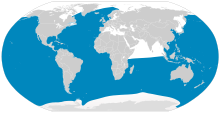
Back Seiwalvis Afrikaans حوت ساي Arabic حوت ساى ARZ Seyval Azerbaijani Сейвал Byelorussian Сэйвал BE-X-OLD Сейвал Bulgarian Balum an hanternoz Breton Rorqual boreal Catalan Balaenoptera borealis CEB
| Sei whale[1] | |
|---|---|

| |
| Sei whale mother and calf | |

| |
| Size compared to an average human | |
| Scientific classification | |
| Domain: | Eukaryota |
| Kingdom: | Animalia |
| Phylum: | Chordata |
| Class: | Mammalia |
| Order: | Artiodactyla |
| Infraorder: | Cetacea |
| Family: | Balaenopteridae |
| Genus: | Balaenoptera |
| Species: | B. borealis
|
| Binomial name | |
| Balaenoptera borealis Lesson, 1828
| |
| Subspecies | |
| |

| |
| Sei whale range | |
| Synonyms | |
| |
The sei whale (/seɪ/ SAY,[4] Norwegian: [sæɪ]; Balaenoptera borealis) is a baleen whale. It is one of ten rorqual species, and the third-largest member after the blue and fin whales. It can grow to 19.5 m (64 ft) in length and weigh as much as 28 t (28 long tons; 31 short tons). Two subspecies are recognized: B. b. borealis and B. b. schlegelii. The whale's ventral surface has sporadic markings ranging from light grey to white, and its body is usually dark steel grey in colour. It is among the fastest of all cetaceans, and can reach speeds of up to 50 km/h (31 mph) over short distances.
It inhabits most oceans and adjoining seas, and prefers deep offshore waters. It avoids polar and tropical waters and semi-enclosed bodies of water. The sei whale migrates annually from cool, subpolar waters in summer to temperate, subtropical waters in winter with a lifespan of 70 years. It is a filter feeder, with its diet consisting primarily of copepods, krill, and other zooplankton. It is typically solitary or can be found in groups numbering half a dozen. During the breeding period, a mating pair will remain together. Sei whale vocalizations usually lasts half a second, and occurs at 240–625 hertz.
Following large-scale commercial whaling during the late 19th and 20th centuries, when over 255,000 whales were killed, the sei whale is now internationally protected. It is listed as endangered by the IUCN Red List, despite increasing populations. The Northern Hemisphere population is listed under CITES Appendix II, which indicates they are not threatened with extinction, while the Southern Hemisphere population is listed under CITES Appendix I, indicating that they are threatened and are given the highest levels of protection.
- ^ Mead, J. G.; Brownell, R. L. Jr. (2005). "Order Cetacea". In Wilson, D. E.; Reeder, D. M. (eds.). Mammal Species of the World: A Taxonomic and Geographic Reference (3rd ed.). Johns Hopkins University Press. pp. 723–743. ISBN 978-0-8018-8221-0. OCLC 62265494.
- ^ Cooke, J.G. (2018). "Balaenoptera borealis". IUCN Red List of Threatened Species. 2018: e.T2475A130482064. doi:10.2305/IUCN.UK.2018-2.RLTS.T2475A130482064.en. Retrieved 4 May 2021.
- ^ "Appendices | CITES". cites.org. Retrieved 14 January 2022.
- ^ "sei whale". Oxford English Dictionary (Online ed.). Oxford University Press. (Subscription or participating institution membership required.)
